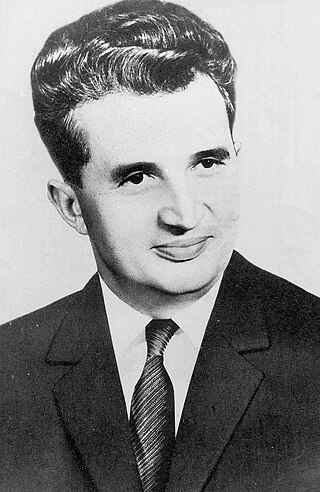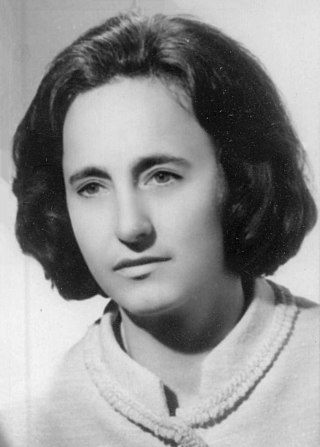
Nicolae Ceaușescu was a Romanian communist politician and dictator. He was the general secretary of the Romanian Communist Party from 1965 to 1989, and the second and last communist leader of Romania. He was also the country's head of state from 1967, serving as President of the State Council and from 1974 concurrently as President of the Republic, until his overthrow and execution in the Romanian Revolution in December 1989, part of a series of anti-Communist uprisings in Eastern Europe that year.

Manea Mănescu was a Romanian communist politician who served as Prime Minister for five years during Nicolae Ceaușescu's Communist regime.

Valentin Ceaușescu is a Romanian physicist. He is the eldest and only surviving child of former communist President Nicolae Ceaușescu and Elena Ceaușescu.

Ilie Ceaușescu was a Romanian army general and communist politician who was Deputy Defence Minister of Communist Romania during the rule of his older brother, Nicolae Ceaușescu.
Abortion in Romania is currently legal as an elective procedure during the first 14 weeks of pregnancy, and for medical reasons at later stages of pregnancy. In the year 2004, there were 216,261 live births and 191,000 reported abortions, meaning that 46% of the 407,261 reported pregnancies that year ended in abortion.

Elena Ceaușescu was a Romanian communist politician who was the wife of Nicolae Ceaușescu, General Secretary of the Romanian Communist Party and leader of the Socialist Republic of Romania. She was also the Deputy Prime Minister of Romania.

Ștefan Andrei was a Romanian communist politician who served as the Minister of Foreign Affairs of Romania from 1978 to 1985. He was arrested after the 1989 overthrow of the Nicolae Ceaușescu regime.
Ilie Văduva was a Romanian communist politician who served as the Minister of Foreign Affairs of Romania from 1985 until 1986, Minister of Foreign Trade and International Cooperation from August 26, 1986 until May 1988 and Presidential Counselor from December 1988 until December 1989. He was one of those arrested after the 1989 overthrow of the Nicolae Ceaușescu regime.

Ioan Totu was a Romanian communist politician who served as the Vice Prime Minister of Romania from 1982 to 1985 and as Minister of Foreign Affairs from 1986 to 1989, during the rule of Nicolae Ceaușescu. He briefly served as President of the State Planning Committee in late 1989.
Ion Stoian is a Romanian former communist politician who briefly served as the Minister of Foreign Affairs of Romania in 1989, during the rule of Nicolae Ceaușescu.
Parliamentary elections were held in the Socialist Republic of Romania on 17 March 1985. The Front of Socialist Unity and Democracy (FDUS), dominated by the Romanian Communist Party (PCR) and including other mass organisations, was the only group to contest the elections, and no prospective candidate could run for office without the Front's approval. Consequently, FDUS candidates won all 369 seats in the Great National Assembly, also ensuring the rubber-stamp confirmation of Nicolae Ceaușescu as President of Romania. The Assembly which elected him included several members of the Ceaușescu family, namely his wife Elena, son Nicu, and brother Ilie. Continuity was also ensured by other incumbents, including Nicolae Giosan as Assembly chairman and Constantin Dăscălescu as Prime Minister.

Nicolae Militaru was a Romanian soldier and communist politician. Rising to the rank of general by the 1960s, his ties to the Soviet Union led dictator Nicolae Ceaușescu to question his loyalty and sideline Militaru in 1978. He re-emerged during the Romanian Revolution, when he was made Defense Minister, serving for nearly two months before street pressure forced his dismissal. Days after Ceaușescu’s execution, he was advanced to general of the army. His final public act came in 1996, when Militaru ran for President, barely registering any support.
The trial of Nicolae and Elena Ceaușescu was held on 25 December 1989 by an Exceptional Military Tribunal, a drumhead court-martial created at the request of a newly formed group called the National Salvation Front. Its outcome was pre-determined, and it resulted in guilty verdicts and death sentences for former Romanian President and Romanian Communist Party General Secretary, Nicolae Ceaușescu, and his wife, Elena Ceaușescu. The main charge was genocide. Romanian state television announced that Nicolae Ceaușescu had been responsible for the deaths of 60,000 people; the announcement did not make clear whether this was the number killed during the Romanian Revolution in Timișoara or throughout the 24 years of Ceausescu's rule.

Cenaclul Flacăra was a cultural and artistic movement in the Socialist Republic of Romania led by poet Adrian Păunescu. Between 1973 and 1985, it organized shows and concerts which, although rebellious in comparison to the official entertainment, promoted Nicolae Ceaușescu's cult of personality and the ideology of National Communism.
The Penal Code of Romania is a document providing the legal basis regarding criminal law in Romania. The Code contains 446 articles. The articles mention aspects such as the national boundaries of law and the crimes that fall under the incidence of penal law. Judicial discretion is granted by the Code through the use of minimum and maximum sentences. The most recent version of the Romanian Penal Code has come into effect on 1 February 2014.
Homosexual acts in Romania were decriminalized on September 6, 2001.
This is a list of 1989 events that occurred in Romania.

The de-satellization of the Socialist Republic of Romania from the Soviet Union was the release of Romania from its Soviet satellite status in the 1960s. The Romanian leadership achieved the de-satellization partly by taking advantage of Nikita Khrushchev's errors and vulnerabilities. Romania's independence was tolerated by Moscow because its ruling party was not going to abandon communism. Although Romania remained a member of both the Warsaw Pact and Comecon, it was not to be a docile member of either.

The Romanian rural systematization program was a social engineering program undertaken by Nicolae Ceaușescu's Romania primarily at the end of the 1980s. The legal framework for this program was established as early as 1974, but it only began in earnest in March 1988, after the Romanian authorities renounced most favoured nation status and the American human rights scrutiny which came with it. The declared aim of this program was to eliminate the differences between urban and rural, by the means of razing half of Romania's 13,000 villages and moving their residents into hundreds of new "agro-industrial centers" by 2000. The program gained notoriety in Europe, with protests from multiple countries – chiefly Hungary – as well as a Belgian-led initiative to save the Romanian villages by "adopting" them. Within a year, on 18 April 1989, the first batch of 23 new agro-industrial towns was completed. Only one new town was created between 1974 and 1988, as Ceaușescu focused his attention on other projects. Although cut short by the Romanian Revolution in December 1989, at least three more rural settlements in an advanced state of systematization were, ultimately, transformed into towns as well.
This is a list of 1965 events that occurred in the Socialist Republic of Romania.











